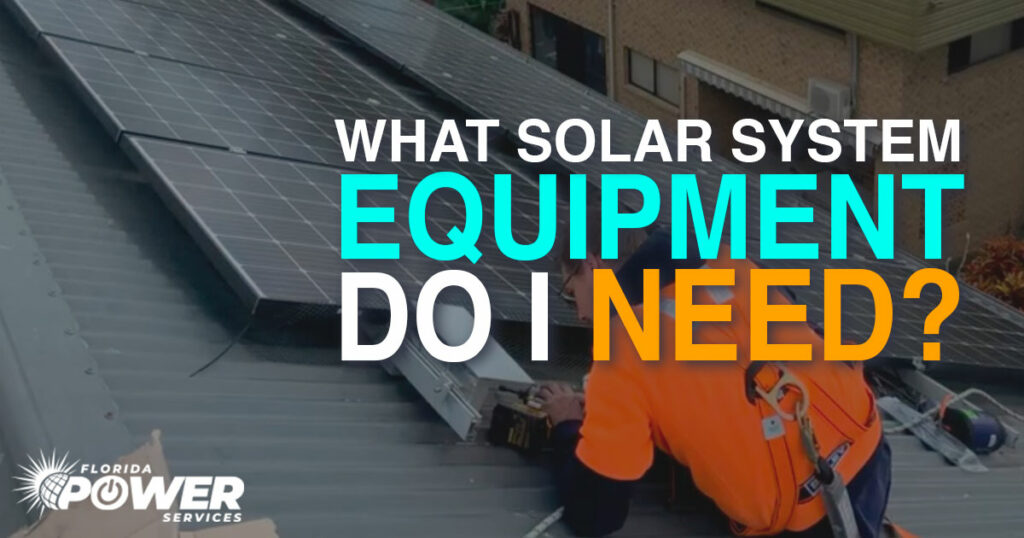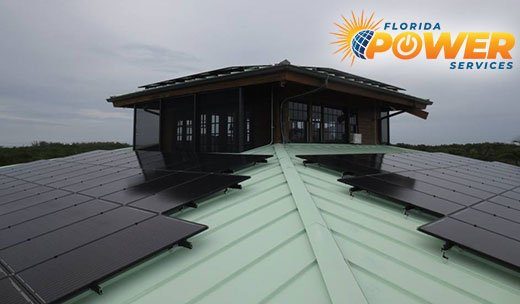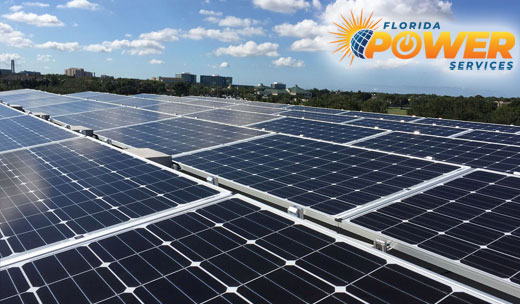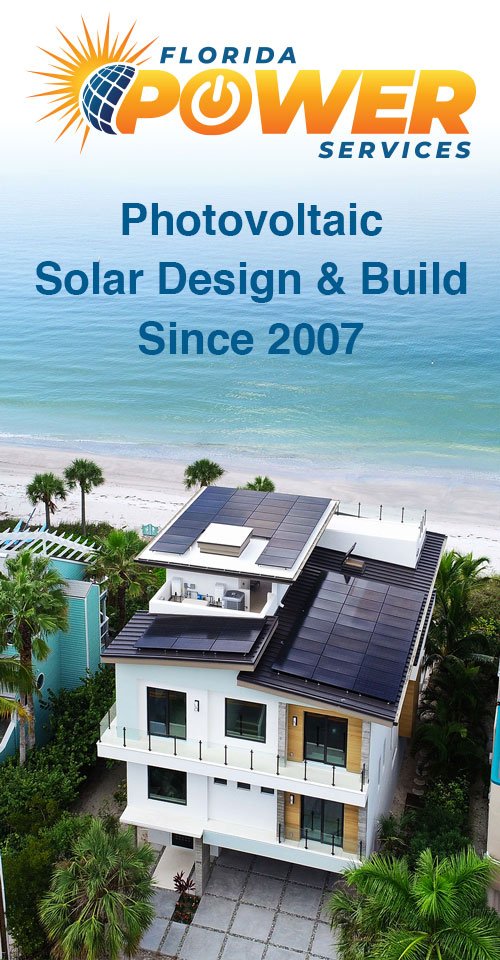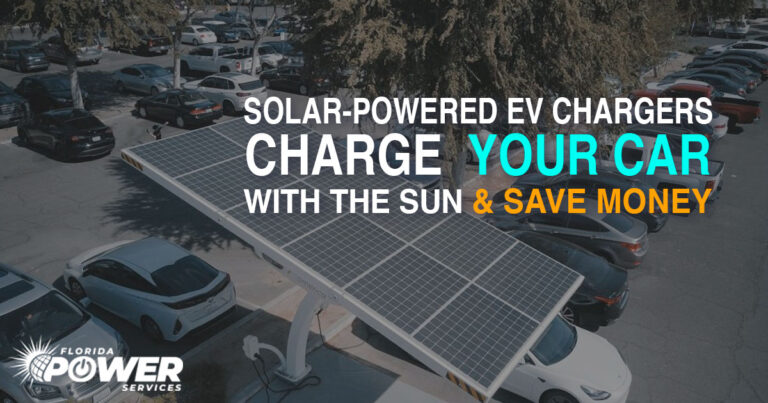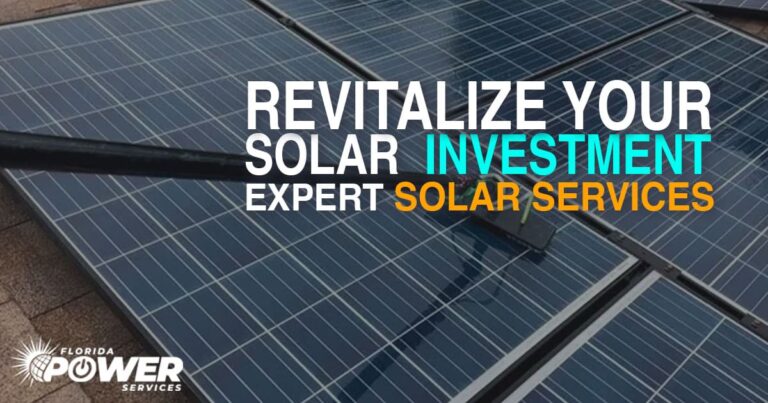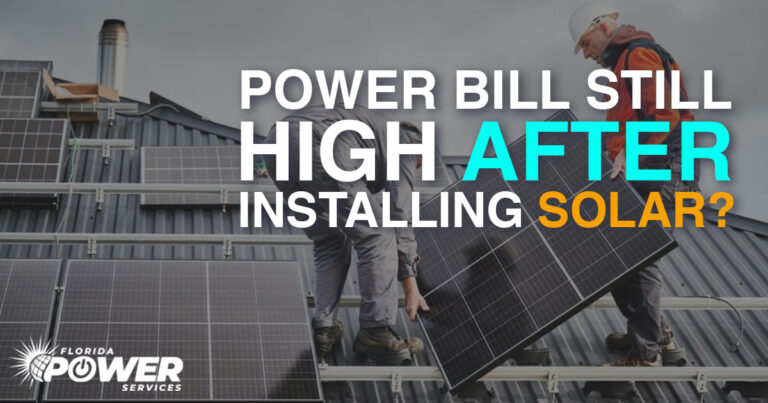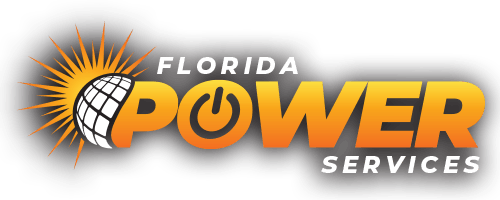Acquiring the right
solar system equipment can be a complicated task, yet it’s crucial in offsetting your utility usage through solar energy.
Making the wrong choices can cost you time and money, so
Florida Power Services ‘The Solar Power Company’ has taken the guesswork out with these equipment recommendations.
We’ve been designing and installing solar systems in Florida since 2002. Working with our on-staff engineer, our photovoltaic systems are carefully designed using only the best components from trust manufacturers.
Wind load requirements and salt-spray ratings are critical in your solar system equipment choices in Florida.
By following our guide, your system can stand the test of time whether you live on the hurricane-prone coastlines or the center of Florida.
We’ll cover:
Florida Solar System Equipment List
What Solar Panels Do I Need?
Solar panels (also known as ‘photo-voltaic modules’ or ‘PV panels’) are a group of photovoltaic solar cells mounted to a frame. These are what you see on the top of roofs. They capture sunlight as a source of energy, which is converted into electrical energy.
When deciding on the panels for your
solar system equipment list, you should consider:
1. Where the solar panels are manufactured? (Many other components can be imported from other countries, but North American-made solar panels will be made with high-quality materials and meet regulations with high standards).
2. How long has the manufacturer been in business? (Look for long-standing, trusted companies only)
3. How long is the warranty? (They should last for at least a decade, but ideally two).
4. What color are the solar panels? (Black cells are typically more expensive, but color choice is usually down to preference).
With dozens of new manufacturers popping up each month, you’ll eliminate the majority of less reliable panel options by following these questions.
Our Solar Panel Recommendations:
We’ve been using these two manufacturers’ solar panels since our inception in 2007. Both have seen excellent performances.
Both manufacturers have strong balance sheets and a very low risk of going out of business.
- Manufactured: Georgia
- Founded: 1999
- Warranty: 25-Year Power Output
- Color: Black Cells, White Back Sheet, Silver Frame
- Manufactured: Ontario
- Founded: 2001
- Warranty: 25-Year Power Output
- Color: Black Cells, Black Back Sheet, Black Frame
What Solar Inverters Do I Need?
Solar inverters (or ‘PV inverters’) are a type of component that converts the energy collected by your solar panels into usable energy for your home and, if necessary, can be fed back into the grid.
Solar inverters are critical in allowing you to use your solar energy. Without a reliable one, you’ll be left without solar energy and higher utility bills.
Micro Inverters are the best option for energy harvest, warranty, monitoring and future-proof battery compatibility.
Our Solar Inverter Recommendations
Florida Power Services ‘The Solar Power Company’ considers Enphase the best solar inverter option on the market today. With Enphase, each panel gets its own inverter so there is no single point of failure on the system.
The Enphase monitoring portal ‘Enlighten’ is the most advanced solar monitoring platform to date, providing real time insight into your solar system’s performance.
Enphase systems are also easily expandable for future system growth and battery compatibility, so you can easily add-on new additions when battery tech matures.
- Manufactured: Canada/China
- Founded: 2006
- Warranty: 25 Years
- Features: Online Monitoring, Good Shade, Mitigation, Flexible Panel Placement, Good Battery compatibility, Expandable.
- Manufactured: Germany/China
- Founded: 1981
- Warranty: 10 Years
- Features: Online Monitoring, Cost Effective, Good Track Record.
What Solar Racking Should I Trust?
Racking is the system used to safely fix your solar panels to surfaces, such as your roof or yard. This piece of solar system equipment is one of the most overlooked when comparing solar quotes. Many companies don’t like to talk about racking and with nothing specified, they end up using the cheapest option).
You must select a racking system that can meet the loading requirements for your location. Parts of our beautiful state have very high wind speeds and making sure the panels don’t fly off the roof during a hurricane is part of protecting your investment as well as ensuring code compliance with the Florida Building Code.
Our Racking Recommendations
We believe there’s really only one choice when it comes to solar racking. Ironridge. With the strongest solar rail on the market, their racking is UL Listed meaning it meets requirements.
- Manufactured: CA
- Founded: 1995
- Warranty: 25 Years
- Features: Anodized Aircraft Grade Aluminum, UL Listed, Miami Dade Approved, Strongest Solar Rail On The Market, Roof & Ground Configurations
Where Should I Mount My Solar System Equipment?
Solar mounting is a critical piece of solar system equipment that ensures the efficiency of your solar panels. It is the framework that allows the panels to rest comfortably, at the optimal angle for maximum energy generation.
85% of solar systems Florida Power Services install are roof mounted. It’s empty real estate and is out of sight and out of mind in most cases.
Occasionally a ground mounted configuration can be more appropriate, for example on existing tile roofs or if the client prefers to make use of the space under the array, using a carport configuration. However, steel and concrete can make the installation more costly so roof mounting is preferred.
What Solar Batteries Should I Get?
Solar batteries are energy stores that you can add to your solar power system to store and access electricity from your solar panels.
They’re great in times of need, such as when the grid is down in a hurricane, or at night or during cloudy days.
Our Solar Battery Recommendations
The Enphase Encharge platform is the most advanced battery option available in the market today with many advantages over other brands.
One of the nicest features about Encharge is its seamless communication between the batteries and the solar panels. On one app, you can get all the information about your solar system including panels, batteries and energy usage in the home.
- Manufactured: CA/China
- Founded: 2006 Warranty: 10 Years
- Features: Online Monitoring, Expandable, Load Management, Communicates With Solar. With multiple inverters in each battery in the unlikely event of a failure the battery will still be able to output power.
What Solar Battery Bank Size Do I Need?
Sizing the battery bank properly is essential for off-grid performance.
Making sure you have enough kWh in your solar batteries to make it through the night is our number one priority, when looking at your power needs and goals for your battery bank.
If you don’t have enough energy stored (kWh) or amps (Output), your home can be left in the dark or worse tripping breaking and causing fault codes (putting the battery into safe mode and requiring a
repair and service call to reset).
This table below should help you understand what system size you need to fit your solar solar system equipment needs:
| Solar Battery Bank Size |
Output |
10 Sec Output |
Loads |
| 6 kWh |
10 A |
16 A |
Fridge, Router, 2 LED Lights,
Microwave. |
| 10 kWh |
16 A |
23 A |
Fridge, Router, 2 LED Lights, Microwave,
Bedroom Circuit. |
| 20 kWh |
46 A |
46 A |
Fridge, Outlet, Router, 2 LED Lights,
Microwave, Bedroom Circuit, Garage
Door, TV, Computer, Well Pump. |
| 30 kWh |
66 A |
66 A |
Fridge, Outlet, Router, 2 LED Lights,
Microwave, Bedroom Circuit, Garage
Door, TV, Computer, Well Pump, Hybrid
Water Heater, Mini Split.
(Manually Manage Large Loads) |
| 40 kWh |
95 A |
95 A |
200A Whole House Pass Through.
(Manually Manage Large Loads) |
Solar Battery Frequently Asked Questions (FAQs)
fhur
Do I Need Batteries To Reach Net Zero?
No. Most people don’t know that batteries are optional. Florida for the most part has a decent net metering policy that is solar friendly so there’s no need to discharge the batteries daily to be at net zero.
You can feed your excess kWh to the utility through the bi directional meter for credits and use them when you need them, like at night or in the summer when your usage is higher.
The utility company acts as your free battery more or less and all things considered our grid is pretty stable.
Can I Add The Batteries At A Later Date?
Yes. A lot of our clients opt for a phased approach to batteries choosing to do the solar first and then wait a year or two to add the batteries. This also gives the battery technology time to improve giving you a better product and lower cost.
How Many Batteries Will I Need To Run My AC?
In the event of an outage you need enough kWh in your battery bank to power the AC from sundown to sun up or you could be left sweating in bed in the middle of the night. Temperature and the draw of your AC are the two biggest variables.
We would recommend 4 – 10 kWh batteries for a 40 kWh battery bank. You may be able to manually manage the loads on a 30 kWh battery bank for a smaller house but our advice is you’d rather have more than not enough.
When Is the Next Generation of Batteries Due To Be Released?
Enphase has told us they are scheduled to release the next generation of Encharge in fall of 2023. The rumors from the engineering department are promising 2x the output and a 20% price reduction
Start Your Florida Solar Installation Today!
If you want to know what solar system equipment you need to optimize your home’s location then contact our
Florida solar panel installation team today.
Florida Power Services ‘The Solar Power Company’ is a highly rated, fully certified local solar company that can help you install a dream, rooftop solar system. We also provide financing and plans to give you the best return on investment.
We welcome you to contact us today or call (727) 667-9955 to install solar panels in Tampa. The quote you get, will be kept!

